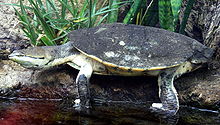| Phrynops hilarii | |
|---|---|

| |
| Scientific classification | |
| Domain: | Eukaryota |
| Kingdom: | Animalia |
| Phylum: | Chordata |
| Class: | Reptilia |
| Order: | Testudines |
| Suborder: | Pleurodira |
| Family: | Chelidae |
| Genus: | Phrynops |
| Species: | P. hilarii |
| Binomial name | |
| Phrynops hilarii (A.M.C. Duméril & Bibron, 1835) | |
| Synonyms | |
List
| |
Phrynops hilarii, also commonly known as Hilaire’s side-necked turtle and Hilaire's toadhead turtle, is a species of freshwater turtle in the family Chelidae. The species is endemic to South America.
Etymology
The specific name, hilarii, is in honor of French zoologist Isidore Geoffroy Saint-Hilaire.
Geographic range
P. hilarii is found in southern Brazil (Santa Catarina and Rio Grande do Sul), southward and westward into Uruguay and Argentina, and possibly also in Paraguay and Bolivia.
Habitat
P. hilarii inhabits streams, lakes, and swamps with abundant aquatic vegetation and soft bottoms.

Description

P. hilarii has an oval, flattened carapace, with a maximum straight-line length of approximately 40 cm (16 in), weighing approximately 5 kg (11 lb). The carapace is usually dark brown, olive, or gray, with a yellow border. The head is large and flat, gray to olive above, with a pointed snout and two bicolored chin barbels. There is a black band on each side of the head, which comes out of the muzzle and passes over the eyes, going up to the neck.
Biology
An omnivorous species, P. hilarii mainly feeds on arthropods, with a preference for copepods, ostracods, and hemipterans. It feeds also on fishes, reptiles, birds, small mammals, and carrion. It is oviparous. This turtle can live for up to 37 years.
Females lay eggs twice a year, one clutch between February and May and the other between September and December. They lay from 9 to 14 eggs, with a maximum of 32 eggs and an incubation period of approximately 150 days.
References
- Duméril, André Marie Constant; Bibron, Gabriel (1835). Erpétologie Générale ou Histoire Naturelle Complète des Reptiles. Tome Second. Paris: Roret. 680 pp. (Platemys hilarii, new species, pp. 428-430). (in French).
- Fritz, Uwe; Havaš, Peter (2007). "Checklist of Chelonians of the World". Vertebrate Zoology. 57 (2): 341. doi:10.3897/vz.57.e30895. ISSN 1864-5755.
- van Dijk, Peter Paul; Iverson, John B.; Shaffer, H. Bradley; Bour, Roger; Rhodin, Anders G.J. (2012). "Turtles of the World, 2012 Update: Annotated Checklist of Taxonomy, Synonymy, Distribution, and Conservation Status". Chelonian Research Monographs (5): 000.243–000.328.
- Beolens, Bo; Watkins, Michael; Grayson, Michael (2011). The Eponym Dictionary of Reptiles. Baltimore: Johns Hopkins University Press. xiii + 296 pp. ISBN 978-1-4214-0135-5. (Phrynops hilarii, p. 123).
- ^ Species Phrynops hilarii at The Reptile Database www.reptile-database.org.
- ^ "Phrynops hilarii ". Turtles of the World
- Cabrera, Mario R.; Colantonio, Sonia E. (2001). "Ontogenetic variation of plastral spotting pattern in Phrynops hilarii (Testudines, Chelidae)" Iheringia, Sér. Zool., Porto Alegre (91): 115–122.
- Alcalde, Leandro; Derocco, Natacha Nara; Rosset, Sergio Daniel (2010). "Feeding in Syntopy: Diet of Hydromedusa tectifera and Phrynops hilarii (Chelidae)" Chelonian Conservation and Biology 9 (1): 3–344.
- "Phrynops hilarii ". AnAge: The Animal Ageing and Longevity Database
Further reading
- Boulenger, George Albert (1889). Catalogue of the Chelonians, Rhynchocephalians, and Crocodiles in the British Museum (Natural History). New Edition. London: Trustees of the British Museum (Natural History). (Taylor and Francis, printers). x + 311 pp. + Plates I-III. (Hydraspis hilarii: p. 220, figure 59, three views of skull; p. 221, figure 60, carapace and plastron; p. 222, species description).
| Taxon identifiers | |
|---|---|
| Phrynops hilarii | |
This article about a turtle is a stub. You can help Misplaced Pages by expanding it. |